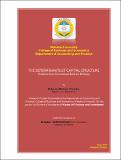| dc.description.abstract | Although there have been many prior studies of the determinants of capital
structure, the question of what determines the best financing mix that maximizes a
firm’s value is still the most debatable issue in corporate finance. Besides, a great
deal of previous studies focused mainly on developed countries’ non-financial firms
paying little attention to developing countries and financial sector. Therefore, this
study attempted to fill the gap by analyzing the capital structure for commercial
banks in Ethiopia. This paper approached the issues of capital structure by
evidencing commercial banks in Ethiopia to uncover the firm level determinant
factors of capital structure. To discover what determines capital structure, six firm
level explanatory variables (Profitability, Tangibility, Size, Growth, Age and Tax-
Shield) were selected and regressed against the appropriate capital structure
measure (Debt to Equity Ratio). A sample of seven commercial banks was taken
and secondary data were collected. Consequently, multivariate regression analysis
was made based on financial statement data of the selected commercial banks over
the study period of 2000 - 2009 E.C. The major findings of the study indicated that
profitability, size, age and tax-shield variables are the significant firm level
determinants of capital structure in Ethiopian commercial banks case. In addition to
this, the two variables (profitability and growth) established negative relationship
and the remaining four variables (tangibility, size, age and tax-shield) showed
positive relationship with capital structure. Far beyond this, it is also revealed that
there is consistency between profitability and Pecking order theory, tangibility and
Static Trade-off theory, Pecking order theory and Agency cost Theory; both
variables size and growth and Static Trade-off theory and Agency cost Theory; and
variables age and tax-shield and Static Trade-off Theory in Ethiopian commercial
banking case. | en_GB |


